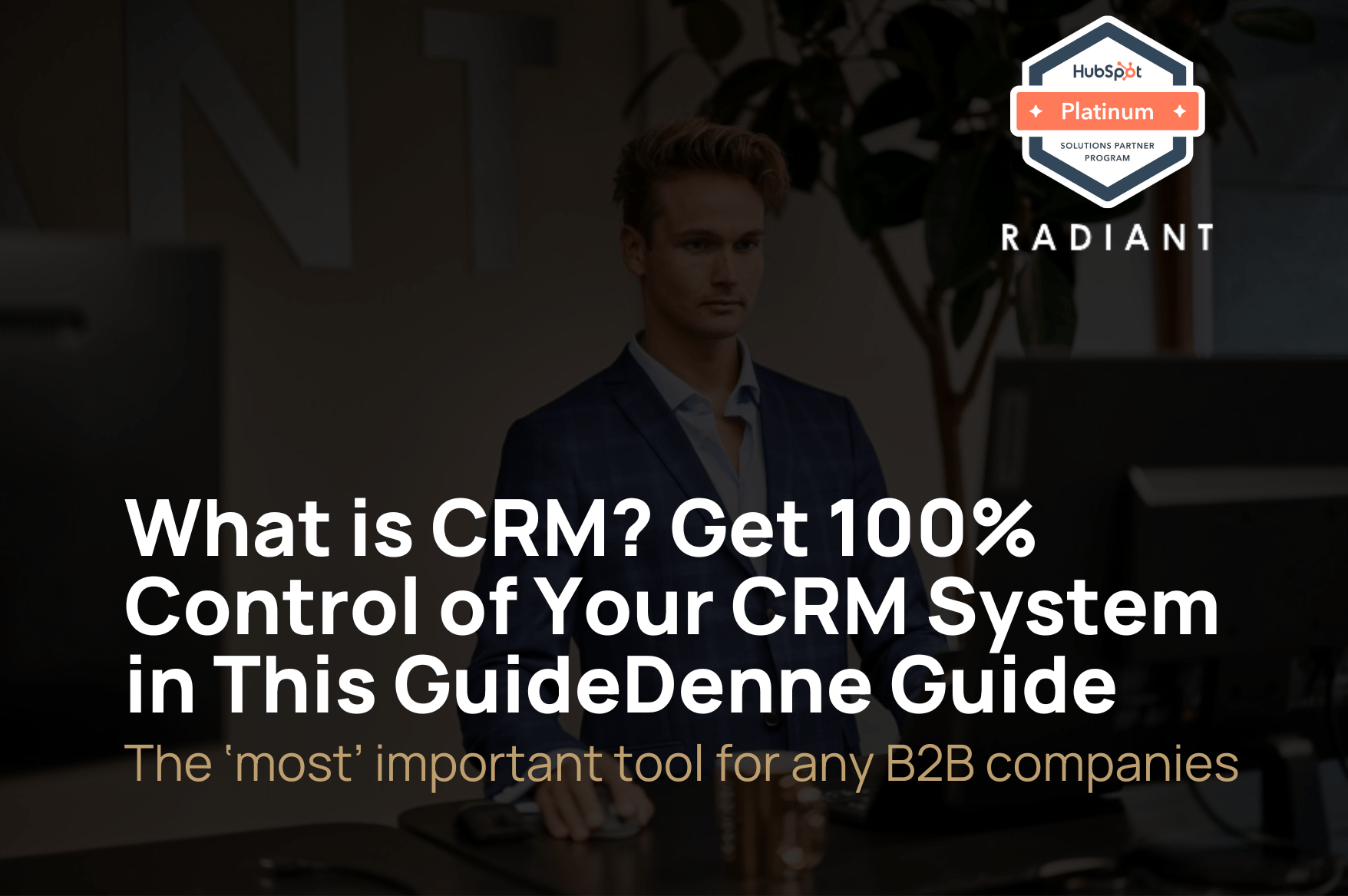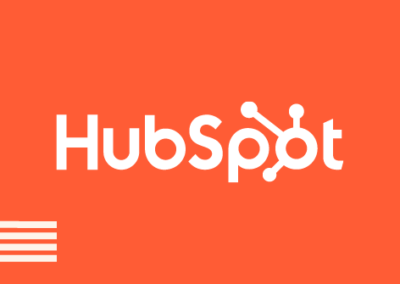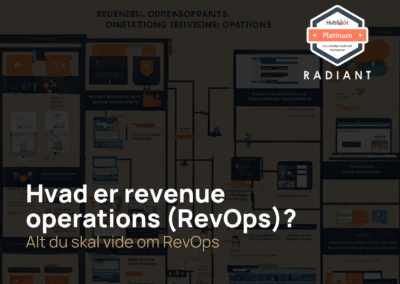CRM, or Customer Relationship Management, is a digital tool that focuses on improving and strengthening your company’s relationships with customers. In a world where customer satisfaction is the key to success, CRM has become an indispensable part of every company’s toolbox.
A CRM is where your business stores all its customer, deal and partner data and manages its activities – including marketing, sales, operations, customer service and CMS – from one streamlined platform.
Benefits of CRM
There are many benefits to implementing a CRM system. The benefits depend on whether your business is primarily B2B or B2C. Next, it’s important to determine what’s important to your business. For example, do you have a long sales, marketing, customer service process or a large operations department?
Generally speaking, there are the following benefits of a CRM platform:
Improved customer insights
With a CRM system, companies can easily and quickly access all relevant customer information. This leads to faster and more accurate responses to customer queries and the opportunity for upselling.
Effective data management
One of the clear benefits CRM systems offer businesses is the ability to better utilize their data. All customer information is gathered in one place, reducing administration and improving collaboration between teams. This allows the marketing team to use what the sales team enters and vice versa when approaching potential customers.
Increased efficiency and productivity
A major advantage of a CRM solution is that all data is gathered in one platform where the entire company can see it and work from it. This means you can break down silo thinking and improve collaboration within and across departments. A CRM can also help you automate everything from email marketing to customer service, freeing up time and resources.
Insights and reporting
CRM systems provide in-depth analytics and reports that help you understand customer behaviour and preferences. Likewise, a CRM system can help you get an overview of internal activity and the distribution of activity. A concrete example of this is being able to see how many emails or phone calls your sales team takes in a day.
How to implement a CRM tool
Below we walk you through step-by-step how to implement a CRM system, choose the right CRM and train your employees/colleagues to use it, as well as how to integrate your CRM with existing technologies.
Step-by-step guide to implementing a CRM system
Implementing a CRM system is a lengthy process that requires several steps:
1. Get an overview
Start by getting an overview of your business needs. It’s important to understand what you need. Are you a company with a long sales process, many marketing activities or a complex demo? Do your customers need particularly comprehensive customer service?
Your needs are incredibly important to know because CRM systems differ by offering specialization in a specific topic such as sales, marketing or customer success. The right CRM system is designed to help with the specific area of your needs.
2. Research the market
Once you have an overview and prioritized your CRM requirements, you can start researching which suppliers can meet your needs. It’s important to consider your growth, ease of use and the ability to integrate with your existing tech stack.
Here you’ll find our comparison of popular CRM systems.
3. implement
Once you’ve chosen the right CRM system for your business, you need to start implementing your CRM system. This is where the road divides:
- If you have previously had another CRM system, it will take longer to implement a new one because you will need to transfer existing data to the new CRM system.
- If you don’t have a CRM system yet, it’s a no-brainer.
If you’ve previously had a CRM system, it’s important to get as much clean, relevant and usable data into the new one as possible. Most people do this by moving all the data into Excel, where you ‘map’ the data to the correct places and make sure there are no duplicates and that the data is linked to a specific property – e.g. an ID or CVR number that is unique.
Having trouble with the above? Are you using HubSpot or considering using it? See how Radiant can help you solve the problem with HubSpot as a Service.
Train your colleagues and/or employees to use your new CRM system
Once you’ve implemented your new CRM platform, it’s important that your employees and/or colleagues learn to use your CRM like any other tool and understand the CRM strategy. Your new CRM tool shouldn’t be seen as just another tool you use, but rather as the link throughout your business. This means that if marketing does something, it affects every other department – and vice versa.
That’s why it’s important that you make sure your colleagues and/or employees get the system training they need. This can be done through internal training and/or external training. This is where a CRM system like HubSpot comes in handy, as they offer HubSpot Academy, which is filled with a lot of concrete learning for free.
Integrate your CRM tool with your existing tech stack
Integrating your CRM platform with your existing tech stack is incredibly important for your colleagues and/or employees’ utilization of your new CRM tool. There will always be a drop in productivity when transitioning to a new tool, such as a CRM system. That’s why integrating your new CRM with the right solutions is essential for business efficiency. Likewise, there are a lot of external integrations that are at the forefront of their respective technologies. Some of the most popular integrations include
Best practices for CRM
Below are some of our best practices when implementing and choosing a CRM system.
Get a CRM system that matches your needs and growth
Choosing the right CRM system is crucial for any business, big or small. The system must not only meet your current needs but also be able to scale as you grow. By investing in a CRM system that matches your needs now and can grow with you, you ensure continuous productivity and avoid getting caught in a bottleneck as you outgrow your CRM system.
Take control of your data quality from day one
Data quality is the cornerstone of any effective CRM system. Without data quality, the ROI of a CRM system quickly deteriorates significantly. From day one, it’s important to ensure that all data entered into the system is accurate, up-to-date and relevant. This will not only improve customer communication but also ensure that decision-makers have access to reliable data when making important business decisions. Likewise, an advantage of a CRM system, as described earlier, is the ability to automate your work, which only emphasizes the importance of good data quality.
Explore the possibilities of your CRM system and never be satisfied with the status quo
A CRM tool includes countless tools for everything from marketing, and sales to operations and customer service. There are always new opportunities in CRM systems such as HubSpot that can give you a significant advantage over your competitors if you make use of them. It is therefore important to always be up-to-date when it comes to your CRM system.
Understand the big picture in your new CRM system
A CRM system is more than just a database of customers. It’s a tool that can help understand customer behaviour, predict sales trends, automate marketing campaigns and much more. By understanding the big picture and all the features the system offers, you can realize its full potential and create stronger customer relationships.
Ultimately, everything an employee does affects everyone else in the organization, which is why it’s so important to understand that others use what you do.
CRM, or Customer Relationship Management, is a digital tool that focuses on improving and strengthening your company’s relationships with customers. In a world where customer satisfaction is the key to success, CRM has become an indispensable part of every company’s toolbox.
A CRM is where your business stores all its customer, deal and partner data and manages its activities – including marketing, sales, operations, customer service and CMS – from one streamlined platform.
Implement a CRM system with Radiant
At Radiant, we have implemented more than 50 CRM systems, doing integrations and migrations from one CRM system to another. This has resulted in optimized sales processes, marketing processes, use of the latest technology and a system that supports your strategy.




